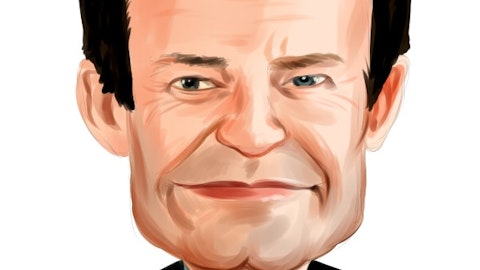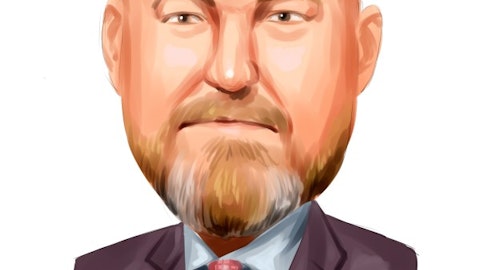Columbia Banking System, Inc. (NASDAQ:COLB) Q4 2022 Earnings Call Transcript January 24, 2023
Operator: Ladies and gentlemen, thank you for standing by. Welcome to the Columbia Banking System’s Fourth Quarter and Full Year 2022 Earnings Conference Call. At this time, all participants are in a listen-only mode. Later, we’ll conduct a question-and-answer session. Instructions will be given at that time. As a reminder, this conference is being recorded. I would now like to turn the call over to your host, Clint Stein, President and Chief Executive Officer of Columbia Banking System. Please go ahead.
Clint Stein: Thank you, Justin. Welcome, and good morning. Thank you for joining us on today’s call as we review our fourth quarter and full year 2022 results, which we released this morning before the market opens. The earnings release and accompanying investor presentation are available at columbiabank.com. It was another exceptional year for Columbia. Our bankers entered 2022 with tremendous momentum on the heels of a record 2021, and they were successful in capitalizing on opportunities, winning new business and providing the necessary capital to allow our customers to grow and expand. We extended our footprint into Utah and Arizona during the year, all the while nurturing our existing client base in an interested rate environment unseen in well over a decade.
That weren’t enough, teams across the bank were simultaneously involved in integration efforts for our merger with Umpqua. And during the first quarter of 2022, we completed the core conversion for our Bank of Commerce Holdings acquisition. Notwithstanding these competing priorities, our bankers delivered outstanding full year results: annual net income exceeded $250 million for the first time in our history; full year EPS expanded by 15% to a new high; loans rose by 11% during the year, after adjusting for PPP runoff; and our operating efficiency ratio fell below 50% in the fourth quarter. Although it took longer than initially expected, on January 9, we announced we had received approval from the FDIC clearing the last regulatory hurdle for our merger with Umpqua.
I’m happy to report that we completed the first of the branch divestiture sales this past weekend, with the second scheduled in February. Consequently, we expect the merger with Umpqua to close February 28 and we are still planning for the systems conversion in March. It’s an understatement to say I’m proud to lead such a talented and committed team. Associates across the company had done an outstanding job over the past 15 months remaining externally focused on all of our stakeholders in addition to preparing for our merger with Umpqua. Our bankers focused on sustaining and growing our normal business activities while simultaneously supporting integration efforts and conversion planning. I want to thank them for their commitment for rising to the challenge as we work towards creating one of the premier banking franchises in the Western U.S. On the call with me today are Aaron Deer, our Chief Financial Officer; and Chris Merrywell, our Chief Operating Officer.
Following our prepared remarks, we will be happy to answer your questions. I need to remind you that we may make forward-looking statements during the call. For further information on forward-looking comments, please refer to either our earnings release or website or our SEC filings. At this point, I’ll turn the call over to Aaron.

Photo by David Dvořáček on Unsplash
Aaron Deer: Good morning, everyone. As Clint noted, full year net income of $250 million and EPS of $3.20 were new annual record. Our performance was a reflection of strong loan growth and rising interest rates combined with solid fee income, well-controlled spending and thoughtfully-managed credit. Excluding costs related to the Umpqua combination and Merchants acquisition of $19.1 million, pre-tax pre-provision income was a record $326 million, exceeding the prior record set in 2021 by $58 million or 22%. Fourth quarter earnings of $68.9 million and EPS of $0.88 represented a linked-quarter increase of $4 million and $0.05, respectively. Quarterly pre-tax pre-provision earnings increased by $1.9 million to $90.9 million due to continued expansion of net interest income.
The core increase was actually larger, but we had higher sequential merger costs, and recall that we had a non-recurring gain of $3.7 million on the building sale on the third quarter. The balance sheet funding mix shifted during the quarter and was supported by an increase of $986 million in short-term borrowings, as deposits declined by $1.2 billion to $16.7 billion. The overall mix of deposits remained superb and our liquidity position remains very strong, providing us with continued deposit pricing flexibility. The loan-to-deposit ratio at year-end was 69%, which remains at the low end of the five-year average preceding the pandemic. Total loans were essentially flat linked-quarter after accounting for $76 million of loans moved to held for sale in preparation for the divestiture of 10 branches as a condition of the Umpqua merger.
Excluding this, new loan production exceeding $400 million was essentially offset by contractual prepayments — rather contractual payments along with an uptick in early prepayments and seasonally lower line utilization. Early repayments were $190 million in the fourth quarter versus $157 million in the third, as more borrowers are choosing to use their liquidity to pay down debt that is repriced to current market rates. The investment portfolio decreased $156 million to $6.6 billion, as paydowns and maturities were partly offset by fair value movement related to the available for sale book. The portfolio was split 31% held to- maturity and 69% available for sale as of year-end. The overall investment securities yield was essentially unchanged at 2.05%, while the duration decreased slightly to 5.2 years.
Our net interest margin continues to benefit from rising rates, increasing 17 basis points linked-quarter to 3.64%, predominantly driven by higher average loan rate and a stronger earning asset mix. Partly offsetting this, our cost of deposits rose relatively modest 8 bps to 18 basis points. Our overall cost of interest-bearing liabilities rose 36 basis points to 58 basis points due mostly to higher FHLB borrowing, though our exceptional deposit base continues to support a favorable overall cost of funds. New loan coupons in the fourth quarter were at an average rate of 6.16%, which compares to 3.57% in the fourth quarter of 2021. Notably, the vast majority of our loans moved above their floors in the latter half of 2022. Noninterest income decreased $3.3 million linked quarter to $23.3 million.
After adjusting to the property sale gain I noted earlier however, noninterest income increased by approximately $400,000, mostly due to BOLI gains of $354,000. We continue to see solid deposit account and treasury management fees with strength in financial services and trust revenue offsetting lower loan revenue due to weakness in mortgage banking activity. Excluding merger-related expenses in the third and fourth quarter, noninterest expense decreased $2.6 million sequentially to $95.6 million, primarily due to lower compensation and benefits expense that we had (ph) cost control across the board. Combined with our strong revenue, operating efficiency dropped to 48% for the quarter. Meanwhile, the effective tax rate remained at level of 21%.
Lastly, credit metrics improved during the quarter, reflecting continued industry-leading asset quality. Nonperforming assets decreased slightly with NPAs at year-end representing just 7 basis points of total assets. And we reported net recoveries of $1.2 million. Despite these favorable trends, we recorded a $2.4 million provision, reflecting a less optimistic economic forecast. As a result, the allowance as a percentage of total loans rose to 1.36% at year-end compared to 1.32% as of September 30. And with that, I’ll turn it over to Chris.
Chris Merrywell: Thank you, Aaron, and good morning, everyone. As Aaron mentioned, solid loan production of $402 million was in line with previous fourth quarters and drove full year production to a new post PPP record of $2.2 billion. While quarterly loan growth was tempered by a normal seasonal reduction in line utilization, loan balances grew to $11.6 billion, representing an increase of 9% during the year and 11% when adjusted for PPP paydowns. Production during the quarter was predominantly split between CRE and C&I. Overall, line utilization fell 2 basis points during the quarter to 47.5%, but was up from 43.3% a year ago. CRE remains well diversified across multiple industries and is well balanced with 54% income properties and 46% owner occupied.
We’re very proud of our bankers and our C&I portfolio continues to reflect their disciplined relationship-based approach. The quarterly production mix was 49% fixed, 41% floating, and 10% variable. The overall portfolio now stands at 54% fixed, 32% floating and 13% variable. PPP loans are no longer a measurable part of the portfolio at only $10 million as of year-end. The geographic distribution of our loan portfolio stands at 48% Washington, 29% Oregon, 10% California, 5% Idaho, with remaining 7% in other states. Deposits fell by $1.2 million — excuse me, $1.2 billion during the quarter and the outflows were due to a variety of factors, including normal seasonal activity and a reversion of excess client liquidity back towards historical levels.
Clients use funds for a variety of purposes to include year-end bonuses and distributions, paying down debt, making investments and moving cash to higher paying alternatives, including approximately $200 million to CB Financial Services during the quarter and almost $800 million during the full year, with the majority of that coming in the second half of the year. The deposit mix shifted slightly during the quarter, with 59% of our deposit sourced from businesses and 41% from consumers as of year-end. And the ratio of noninterest-bearing demand deposits improved from 49.1% at the end of 2021 to 50.1% at the end of 2022. On the fee income front, our wealth management group had yet another record year with over $17 million in revenue. Our retail, commercial and wealth management teams continue to work together in an effort to bank the entire relationship across our clients’ life cycles.
And with that, I’ll turn the call back over to Clint.
Clint Stein: Thanks, Chris. Our regular quarterly dividend of $0.30 was announced this morning. This quarter’s dividend will be paid on February 21 to shareholders of record as of the close of business on February 6. This concludes our prepared comments. As a reminder, Chris and Aaron are with me to answer your questions. And now, Justin, we’ll open the call for Q&A.
See also 11 Most Undervalued Natural Gas Stocks To Buy and 10 Biggest HVAC Companies in the US.
Q&A Session
Follow Second Sainter Co (NASDAQ:COLB)
Follow Second Sainter Co (NASDAQ:COLB)
Operator: Thank you. And our first question comes from David Feaster from Raymond James. Your line is now open.
David Feaster: Hey, good morning, everybody.
Clint Stein: Good morning, David.
Aaron Deer: Good morning, David.
David Feaster: I’d kind of like to follow-up maybe on the deposit front. Maybe you touched on some of the competitive dynamics there. I was wondering if you could maybe help quantify maybe some of the surge deposit outflows versus seasonal dynamics and versus client utilizing cash to pay down higher cost debt. And then, I guess from a competitive standpoint, are you seeing certain geographies maybe more competitive? And do you think we’re through the surge deposits? Just curious on some comments on that front.
Aaron Deer: Sure. This is Aaron. I’ll start, and let Chris clean up for me. But we certainly have seen some revision of excess client funding kind of revert back towards normal levels. I think there’s probably still a little bit more of that to be seen, given some of the analysis we’ve done on that front. But I think if you look overall through the pandemic, we saw outsized inflows relative to a lot of our competitors. Even after the outflows that we saw this quarter, we continue to run ahead of most of our peers. And so, we’re still feeling very good about the — what the deposit flows have been and the mix. And we’ve just continued — and I think a lot of that just reflects our continued discipline in terms of pricing. And I can let Chris talk a little bit more about that.
Chris Merrywell: Sure. Thanks, Aaron. David, yes, you mentioned the part of that is it more competitive in certain markets, and I would tell you it’s — all markets are competitive and it’s different competitors in certain markets, but you’re seeing lots of deposit specials, things of that nature, really happy with the team and how they’re working with our clients to find out what the purpose of the funds were, trying not to become interest rate sensitive when we don’t have to, and utilizing the tools that are available through wealth management and such. But the reality is there are some pretty significant specials that are out there. We’ve used our exception pricing and the discipline around that to keep our costs from going up on that.
But there are some folks that have chosen to pivot into a treasury bill or a CD special or a money market special in another bank. But we’re not seeing that we’re losing the relationships. We’re just seeing a pivot for some — put it more into the hot money category, but we’re really comfortable with the relationships we still have with those clients.
David Feaster: Okay.
Aaron Deer: And, David, also, if you look at the composition of noninterest-bearing as percentage of the total, that continue to be very stable. In fact, it actually ticked up just a little bit sequentially. And just in terms of the loan deposit ratio, if you look back to where that stood, as I mentioned in my opening comments, over the five years preceding the pandemic, it basically ranged between 70% and 85% and we’re still down at the very bottom end of that. So, we’ve still a lot of flexibility




